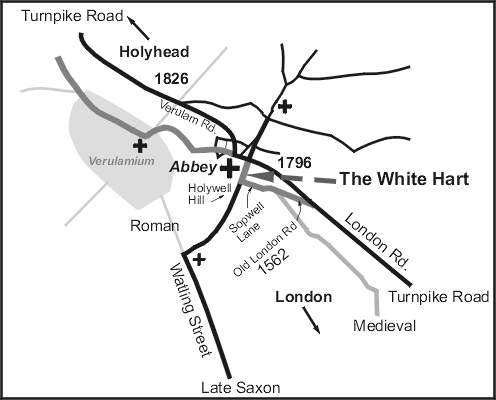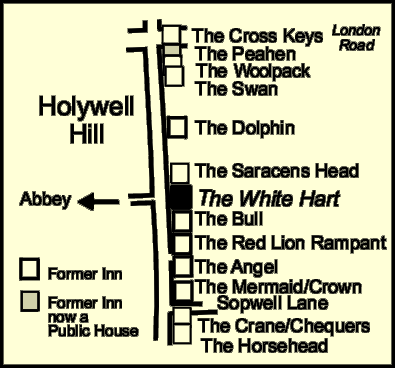|
Back to Archaeology & History Contents
The White HartHolywell Hill
The Sign of the White Hart on an 18th century Tankard
The Yard of the White Hart c.1898
The traveller who in 1792 admitted that, the White Hart was "perhaps the best here", but complained that the inn was, "unequalled in filth, inattention and charge", would appreciate today's service and the many improvements that have been made to this ancient house in recent years; improvements which in no way detract from its historic charm and character.
The Inns of Holywell Hill
|
|
|
In 1577 there were 55 victualling houses in St. Albans, divided into 27 Inns, 26 alehouses and 2 Taverns (where wine was sold). The proportion of inns to alehouses was then the highest recorded in the country. By the 16th/17th Century, if not before, the eastern side of Holywell Hill, from the Sopwell Lane corner, was an almost continuous string of Inns.
Inns came into being in the Middle Ages, from the 12th Century onwards. The first recorded in St. Albans was in 1235-60 when the Abbot acquired a house which was "most suitable for the accommodation of guests". By the 14th/15th centuries the ever increasing cost of hospitality borne by monasteries such as St. Albans Abbey, meant that the provision of inns became popular as a means of reducing their financial burden. After the dissolution of the Abbey in 1539, inns (and breweries) were commonly owned by some of the leading citizens of the town. Inns were superior victualling houses catering for the upper levels of society and places where official and commercial business could be transacted. In 1611 John Moseley, a principal burgess and proprietor of the White Hart left 20s. (£1) to be distributed in bread to the St. Albans poor on the day of his funeral; with the same to be distributed on the following Sunday. In 1606 it was reported to the Borough Court that alehouses and tippling houses were the cause of much drunkenness and looseness and that the many unlicensed alehouses made control impossible. Also there was so much brewing that the increased consumption of firewood led to yearly increases in the cost of fuel. It was resolved that in future only four beer brewers (who produced the hopped drink) and two ale brewers (who produced the unhopped drink) would be allowed in the town. One of the six who gained the privilege of brewing was John Moseley who had been Mayor in 1603! Another Mayor to hold the White Hart was Edward Langford in 1752. It was his widow Mary who was involved in the events of 1770 (see below) The History of The White HartIn 1535 the White Hart, then known as the Hartshorn was leased by the Abbot of St. Albans to John Broke and his wife Elizabeth "with a brewing lede, one growte lede, one tabyll with a peyer of trescells standing in the hall and in the parlour one tabyll with a peyer of trescells and ten bedsteddes". A lede was a lead vessel used in brewing. Clearly home brewed ale was available even if the sleeping accommodation was cramped! Like most old inns the building has been changed and adapted over the years. Today the oldest part is on the south and formed part of an inn built around 1500 and then known as the Hartshorn. The range along the street to the south of the carriageway was built in the 17th Century. To the north of the carriageway is a late 16th Century building, the ground floor now used as a shop. Wall paintings were discovered in a first floor room at the end of last Century; these were large scale compositions with designs including birds, animals and foliage but of great interest is a painting in the ground floor room which was recently re-exposed. This shows the story of Venus and Adonis and seems to be the only known contemporary illustration of a poem by Shakespeare, published in 1593. n the 18th Century the front of the White Hart was plastered and illustrations show that it was "modernised" by the provision of new windows. This gave a unified appearance to the building. The plaster was removed in the early 20th Century to expose the timber frame and the old windows replaced with new ones with leaded panes of 17th Century style, giving the inn its present appearance. The White Hart at the end of the 18th century
In its heyday the inn had extensive stabling and other buildings in the yard but most of the outbuildings were destroyed in a serious fire in 1803. In the later 19th Century a wheelwright worked in the yard. The Jacobite rebel, Simon Fraser, Lord Lovat, stayed in the White Hart in 1746, on his way to the Tower of London. In the 1745 Jacobite rising Lovat had sent his son and his clansmen to fight for Bonnie Prince Charlie while he protested his loyalty to the government. After the Jacobite defeat at Culloden he fled but was captured. Falling ill on the way to London he was lodged here but could not escape his fate; trial for treason and beheading. The last aristocrat to meet this end. It was during his time at the inn that his portrait was painted by the celebrated artist and engraver William Hogarth. There were 26 beds in 1756, the highest number recorded in the town, along with stabling for 50 horses. In that year the town could provide over 250 beds with stabling for more than 700 horses. The inn was involved in scandal and a notorious legal action brought by Lord Grosvenor against the Duke of Cumberland (the brother of King George III) in 1770. The Landlady and Chambermaid were called as witnesses to the events which occurred when Lady Grosvenor stayed there for an assignation with the Duke, who appeared "dressed plain like a country farmer"! These events cost the Duke £10,000 pounds in damages awarded to the lady's husband; Lord Grosvenor. This was one of the Inns where on occasion, especially in the 18th Century, the Mayor and Corporation sometimes met. For example in 1761 they met there to declare war against Spain! On February 3rd, 1762 the Town Hall was "out of repair and inconvenient to meet in" and the inn a more comfortable alternative. The year before, on March 19th, 23 Freeman were admitted at the Borough Court of that day; they then adjourned immediately to the White Hart where the 24th freeman was admitted. In 1815, when a town guidebook recommended the White Hart for, "families and posting", only the White Hart, The Crown, The Woolpack and The Peahen remained as inns on the hill. At some time before 1766, the White Hart had provided itself with its own back entrance which avoided Sopwell Lane. This was done by using the long length of the property which stretched back to the ancient borough boundary and crossing part of Key Field, to link with the Old London Road. Incidentally Key Field was where the Duke of Warwick's Yorkist forces camped prior to the First Battle of St. Albans, the first of the Wars of the Roses, in 1455. In the early/mid 19th Century a beer house, the White Hart Tap, was built at the very end of the property against Key Field; one of several taps which served some of the town's inns. This rear entry eventually became built up as Pageant Road, named after the popular St. Albans open air pageant of 1907. In 1815 it was estimated that the 70 mail and stage coaches which passed through the town daily could accommodate 600 passengers and when travellers on foot were included then the daily total was around 1000 people. The carriageway was the scene of a tragic accident in 1820. Elizabeth Wilson seated on top of the Northampton Coach failed to duck as it swept under the entrance and was killed by the impact. It is said that the harmless ghost of the unfortunate lady haunts the house to this day! This incident provided the inspiration for the similar demise of Mr. Jingle in Charles Dickens' Pickwick Papers. On Sunday 3rd May 1840, Fr. Cook, the Roman Catholic parish priest of Ware, celebrated mass in a room at the White Hart, which he had hired for use as a chapel, the first official place of worship since the reformation. This use continued for some time but by 1847 Catholic services were being held in a chapel attached to the then priest's house in College Street. |



